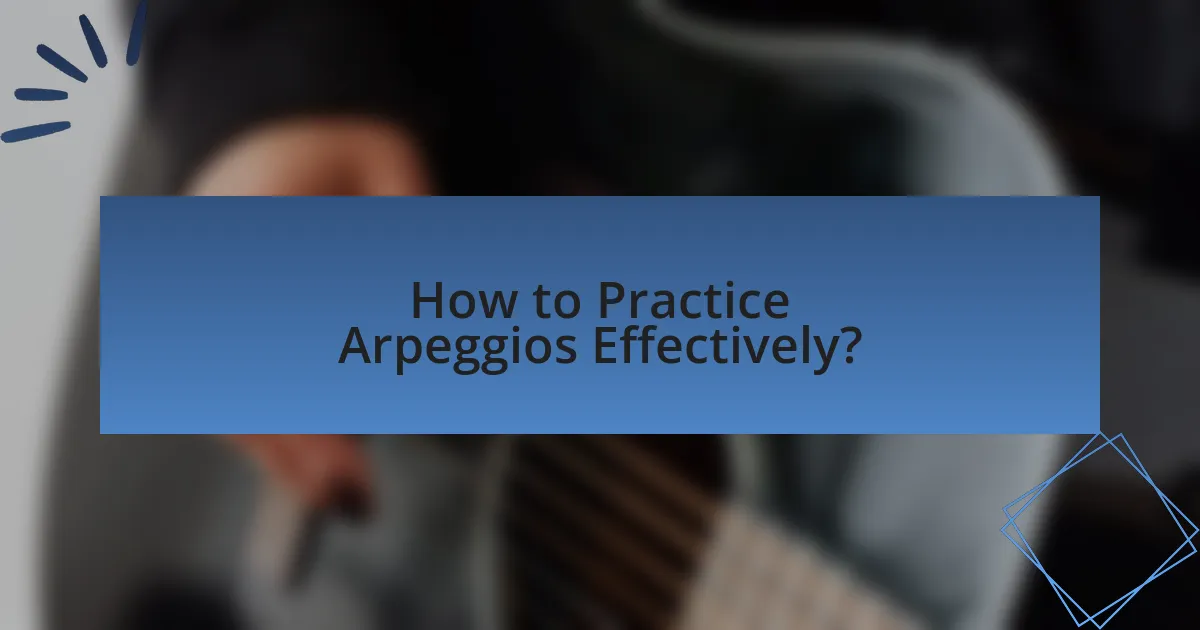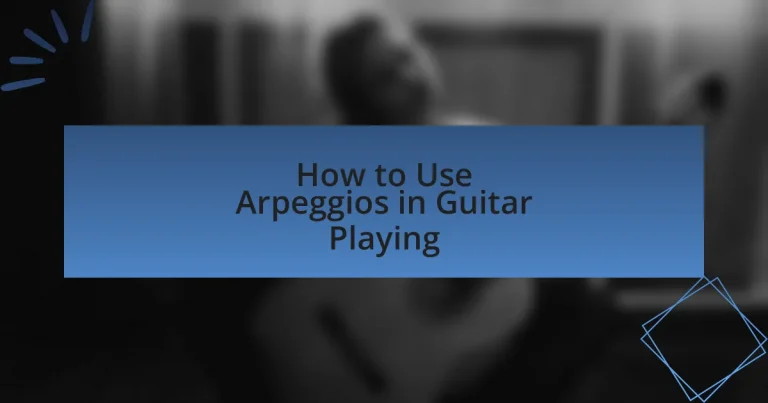Arpeggios are a fundamental technique in guitar playing, involving the sequential playing of the notes of a chord rather than strumming them simultaneously. This article explores the differences between arpeggios and chords, the basic components of arpeggios, and their importance across various musical genres. It also covers different types of arpeggios, techniques for practicing them effectively, and common mistakes to avoid. Additionally, the article provides practical tips for mastering arpeggios, incorporating them into playing styles, and utilizing resources for further learning.

What are Arpeggios in Guitar Playing?
Arpeggios in guitar playing are musical techniques where the notes of a chord are played in succession rather than simultaneously. This method allows guitarists to create melodic lines and add texture to their music. For example, in a C major chord, the notes C, E, and G can be played one after the other, forming an arpeggio. Arpeggios are commonly used in various genres, including classical, rock, and jazz, to enhance musical expression and complexity.
How do arpeggios differ from chords?
Arpeggios differ from chords primarily in their execution; arpeggios involve playing the individual notes of a chord sequentially, while chords consist of playing all the notes simultaneously. This distinction is significant in music theory, as arpeggios create a flowing, melodic line that can enhance the harmonic structure of a piece, whereas chords provide a fuller, more stable sound. For example, in guitar playing, a C major chord played as a chord strikes all three notes (C, E, G) at once, while playing a C major arpeggio would involve picking those notes one after the other, creating a different texture and rhythmic feel.
What are the basic components of an arpeggio?
An arpeggio consists of the individual notes of a chord played in succession rather than simultaneously. The basic components include the root note, the third, and the fifth of the chord, which form the triad. For example, in a C major arpeggio, the notes C (root), E (third), and G (fifth) are played sequentially. This structure allows for melodic movement and harmonic support in music, making arpeggios a fundamental technique in guitar playing.
Why are arpeggios important in guitar music?
Arpeggios are important in guitar music because they allow musicians to play the individual notes of a chord in a sequence rather than simultaneously, creating a more intricate and melodic sound. This technique enhances musical expression and complexity, enabling guitarists to add depth to their compositions and improvisations. Additionally, arpeggios are foundational in various genres, including classical, jazz, and rock, where they serve as essential building blocks for solos and accompaniment. Their use can be traced back to early music, demonstrating their long-standing significance in guitar playing.
What types of arpeggios can be used on the guitar?
The types of arpeggios that can be used on the guitar include major, minor, diminished, augmented, and seventh arpeggios. Major arpeggios consist of the root, major third, and perfect fifth notes of a scale, while minor arpeggios include the root, minor third, and perfect fifth. Diminished arpeggios are formed by the root, minor third, and diminished fifth, and augmented arpeggios consist of the root, major third, and augmented fifth. Seventh arpeggios add a seventh note to the basic triads, resulting in major seventh, minor seventh, dominant seventh, and diminished seventh variations. These arpeggios are foundational in various musical genres and are essential for creating harmony and melodic lines on the guitar.
How do major and minor arpeggios differ?
Major and minor arpeggios differ primarily in their tonal quality, with major arpeggios producing a bright, happy sound and minor arpeggios creating a darker, more somber tone. Specifically, a major arpeggio consists of the root, major third, and perfect fifth of the scale, while a minor arpeggio includes the root, minor third, and perfect fifth. This distinction in the third interval is crucial, as it fundamentally alters the emotional character of the music being played. For example, in the key of C major, the C major arpeggio is composed of the notes C, E, and G, while the C minor arpeggio consists of C, E-flat, and G, highlighting the difference in sound and mood.
What are extended arpeggios and how are they played?
Extended arpeggios are arpeggios that include additional notes beyond the basic triad, often incorporating seventh, ninth, or even higher extensions. They are played by sequentially picking or strumming the individual notes of a chord, allowing for a more complex and rich sound. To execute extended arpeggios on the guitar, a player typically uses fingerpicking or a pick to play the notes in a specific order, often following the chord tones and their extensions, which can be derived from scales such as the major, minor, or dominant scales. This technique enhances musical expression and adds depth to guitar playing, making it a valuable skill for musicians.
How can arpeggios enhance guitar playing?
Arpeggios enhance guitar playing by improving technical skills, musicality, and creativity. They allow guitarists to break chords into individual notes, facilitating smoother transitions between chords and enhancing finger dexterity. This technique also helps in developing a better understanding of harmony and melody, as players learn to connect notes in a more fluid manner. Additionally, incorporating arpeggios into solos can create a more dynamic and expressive sound, making the music more engaging. Studies show that practicing arpeggios can lead to increased speed and accuracy, which are essential for advanced guitar playing.
What role do arpeggios play in improvisation?
Arpeggios serve as essential building blocks in improvisation by providing a structured way to outline chord tones melodically. They allow musicians to create fluid and coherent lines that align with the harmonic framework of a piece, enhancing the overall musicality. By emphasizing the notes of a chord in a sequential manner, arpeggios help to establish a strong connection between the melody and harmony, which is crucial for effective improvisation. This technique is widely utilized across various genres, including jazz and classical music, where improvisation is a key element.
How do arpeggios contribute to melody creation?
Arpeggios contribute to melody creation by providing a structured way to outline chord tones in a melodic context. When musicians play arpeggios, they break down chords into individual notes, allowing for the exploration of melodic lines that are harmonically rich and connected to the underlying chord progression. This technique enhances the expressiveness of melodies, as arpeggios can create tension and resolution, which are essential elements in music composition. For instance, in classical and contemporary music, arpeggios are frequently used to embellish melodies, making them more intricate and engaging.

How to Practice Arpeggios Effectively?
To practice arpeggios effectively, focus on consistent and structured practice sessions that incorporate various techniques. Begin by selecting a specific arpeggio shape, such as major or minor, and play it slowly to ensure accuracy in finger placement and timing. Gradually increase the tempo as you become more comfortable, using a metronome to maintain a steady rhythm. Additionally, practice arpeggios in different positions on the fretboard to enhance your familiarity with the instrument. Research indicates that deliberate practice, which includes breaking down complex patterns into manageable sections, significantly improves skill acquisition in musicians. This method allows for focused attention on challenging areas, leading to more effective learning and retention of arpeggio techniques.
What are the best techniques for practicing arpeggios?
The best techniques for practicing arpeggios include using a metronome, practicing in different positions on the fretboard, and incorporating various picking patterns. Utilizing a metronome helps develop timing and rhythm, allowing guitarists to gradually increase speed while maintaining accuracy. Practicing arpeggios in different positions enhances finger dexterity and familiarity with the fretboard, which is essential for fluid playing. Additionally, incorporating various picking patterns, such as alternate picking or sweep picking, allows for versatility and improves overall technique. These methods are widely recognized among guitar instructors and musicians for their effectiveness in mastering arpeggios.
How can a metronome aid in practicing arpeggios?
A metronome aids in practicing arpeggios by providing a consistent tempo, which helps musicians develop timing and rhythm. When practicing arpeggios with a metronome, players can start at a slow tempo to ensure accuracy in finger placement and transitions, gradually increasing the speed as they become more comfortable. This method reinforces the importance of timing in music, as studies show that consistent practice with a metronome can improve rhythmic precision and overall performance quality.
What exercises can help improve arpeggio skills?
To improve arpeggio skills, practicing finger exercises that focus on different arpeggio patterns is essential. One effective exercise is to play major and minor arpeggios across all strings, ensuring to use alternate picking for precision. Additionally, incorporating sweep picking techniques can enhance fluidity and speed in arpeggio execution. Studies show that consistent practice of these exercises leads to improved dexterity and muscle memory, which are crucial for mastering arpeggios in guitar playing.
How can I incorporate arpeggios into my playing style?
To incorporate arpeggios into your playing style, practice playing arpeggios in various positions on the guitar neck and integrate them into your improvisation and songwriting. This technique enhances melodic lines and adds complexity to chord progressions. For example, using arpeggios derived from common chords, such as C, G, and Am, allows you to create fluid transitions between chords while maintaining a cohesive sound. Additionally, studies show that musicians who regularly practice arpeggios develop better finger dexterity and improved timing, which are essential for advanced playing styles.
What songs effectively use arpeggios for learning?
Songs that effectively use arpeggios for learning include “Blackbird” by The Beatles, “Stairway to Heaven” by Led Zeppelin, and “Dust in the Wind” by Kansas. These songs incorporate arpeggios prominently, allowing learners to practice fingerpicking techniques and understand chord progressions. For instance, “Blackbird” features a series of arpeggiated chords that help develop dexterity and timing, while “Stairway to Heaven” uses arpeggios to create a flowing melodic line that enhances musicality. “Dust in the Wind” is known for its simple yet effective arpeggiated pattern, making it accessible for beginners.
How can I create my own arpeggio patterns?
To create your own arpeggio patterns, start by selecting a chord progression that you want to use as the foundation. For example, if you choose a C-G-Am-F progression, you can break down each chord into its individual notes. Next, decide on a picking pattern, such as ascending, descending, or a combination of both. You can also incorporate rhythmic variations by altering the timing of each note.
For instance, if you take the C major chord (C-E-G), you might play the notes in the order C-E-G-E or C-G-E-G. Experiment with different sequences and rhythms to develop unique patterns. This method allows for creativity while ensuring that the patterns remain musically coherent.
Using this approach, you can generate a variety of arpeggio patterns that fit your style and the music you are creating.

What Common Mistakes Should Be Avoided When Using Arpeggios?
Common mistakes to avoid when using arpeggios include neglecting proper finger positioning, which can lead to inefficient playing and increased tension. Additionally, failing to maintain a consistent rhythm while playing arpeggios can disrupt the musical flow, making the performance sound unpolished. Another mistake is overusing arpeggios in a piece, which can make the music feel monotonous and predictable. Lastly, not practicing arpeggios in different keys and positions limits a guitarist’s versatility and understanding of the instrument. These mistakes hinder a guitarist’s ability to effectively incorporate arpeggios into their playing.
What are the pitfalls of playing arpeggios too fast?
Playing arpeggios too fast can lead to several pitfalls, including loss of clarity and precision in note articulation. When guitarists play arpeggios at high speeds, they often sacrifice the distinctiveness of each note, resulting in a muddy sound where individual notes blend together. This can hinder musical expression and make it difficult for listeners to appreciate the intended melody or harmony. Additionally, playing too quickly can increase the risk of technical errors, such as missed notes or incorrect finger placements, which can disrupt the overall performance. Studies in music performance indicate that maintaining a moderate tempo allows for better control and accuracy, ultimately enhancing the quality of the music produced.
How can poor finger positioning affect arpeggio playing?
Poor finger positioning can significantly hinder arpeggio playing by causing inaccuracies in note execution and reducing overall speed. When fingers are not placed correctly on the fretboard, it leads to missed notes, muted strings, and a lack of fluidity in transitions between notes. This is particularly evident in arpeggios, which require precise finger placement to ensure each note rings clearly and in succession. Studies in music pedagogy indicate that proper finger positioning enhances muscle memory and dexterity, which are crucial for executing complex arpeggios efficiently. Therefore, maintaining correct finger positioning is essential for achieving clarity and speed in arpeggio playing.
What should I watch out for in timing and rhythm?
In timing and rhythm when using arpeggios in guitar playing, you should watch out for maintaining a consistent tempo and ensuring even note duration. A steady tempo is crucial as it helps create a cohesive sound, while even note duration prevents unevenness that can disrupt the musical flow. Studies in music theory emphasize that irregular timing can lead to a disjointed performance, making it essential to practice with a metronome to develop a reliable sense of timing. Additionally, being aware of syncopation can enhance rhythmic interest, but it requires careful attention to avoid losing the underlying pulse.
How can I troubleshoot issues with arpeggio playing?
To troubleshoot issues with arpeggio playing, first identify the specific problem, such as timing, finger placement, or string muting. For example, if timing is an issue, practice with a metronome to develop a consistent rhythm. If finger placement is causing difficulty, ensure that your fingers are positioned correctly on the fretboard and that you are using the appropriate finger for each note. Additionally, if string muting is problematic, focus on using your palm to lightly touch the strings that should not be played. Regularly recording your practice sessions can also help you identify and address specific areas that need improvement.
What are the signs of tension while playing arpeggios?
Signs of tension while playing arpeggios include tightness in the fingers, wrists, or shoulders, which can manifest as discomfort or pain during or after playing. Additionally, a lack of fluidity in movement, difficulty in achieving the desired speed, and an inability to maintain a relaxed posture are also indicators of tension. These signs are often accompanied by a decrease in overall performance quality, such as missed notes or a lack of clarity in sound. Recognizing these symptoms is crucial for musicians to address tension and improve their technique.
How can I improve clarity and precision in my arpeggios?
To improve clarity and precision in your arpeggios, focus on practicing with a metronome at a slow tempo to ensure accurate timing and note articulation. This method allows you to develop muscle memory and control over each note, which is essential for clarity. Gradually increase the tempo as you become more comfortable, ensuring that each note remains distinct and clean. Research indicates that consistent metronome practice enhances rhythmic accuracy and overall performance quality in musicians.
What are some practical tips for mastering arpeggios?
To master arpeggios, practice them slowly and gradually increase speed while maintaining accuracy. This method allows for better finger placement and muscle memory development. Additionally, use a metronome to keep a consistent tempo, which helps in timing and rhythm. Incorporating various fingerings and positions on the fretboard enhances versatility and familiarity with different shapes. Regularly transcribing and analyzing arpeggio patterns from songs can also provide practical insights into their application in music. These strategies are supported by the fact that consistent practice and varied approaches lead to improved technical skills and musicality in guitar playing.
How can I set achievable goals for arpeggio practice?
To set achievable goals for arpeggio practice, define specific, measurable, and time-bound objectives. For example, aim to master a particular arpeggio pattern at a slow tempo within two weeks, gradually increasing speed as proficiency improves. Research indicates that breaking down practice into smaller, focused segments enhances skill acquisition, as supported by the principles of deliberate practice outlined by psychologist Anders Ericsson. This structured approach ensures consistent progress and builds confidence in arpeggio execution.
What resources are available for learning arpeggios on guitar?
Online platforms such as YouTube, GuitarLessons.com, and JustinGuitar offer extensive resources for learning arpeggios on guitar. These platforms provide video tutorials, sheet music, and practice exercises specifically focused on arpeggio techniques. For example, JustinGuitar features structured lessons that break down arpeggio patterns and their applications in various musical styles. Additionally, instructional books like “Arpeggio Madness” by Joseph Alexander and “Guitar Arpeggio Handbook” by David Hodge provide comprehensive guides and exercises for mastering arpeggios. These resources are widely recognized in the guitar community for their effectiveness in teaching arpeggio techniques.


